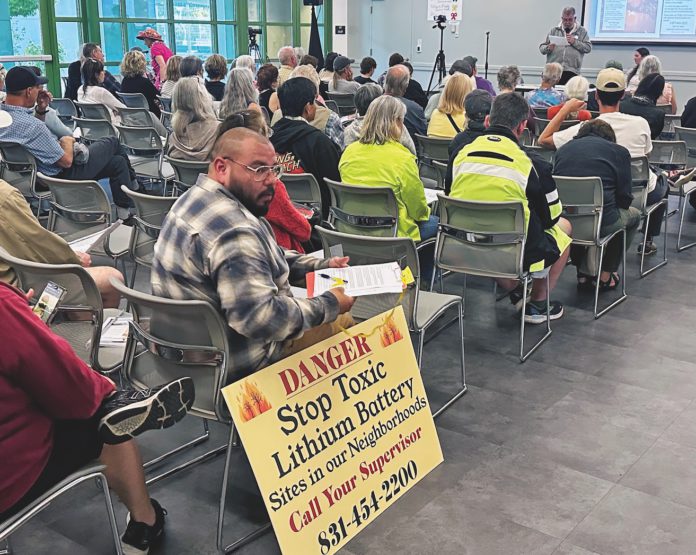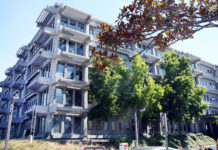
About 150 people gathered in Santa Cruz July 17, for a third meeting held over the past few months to send the message that proposed Battery Energy Storage Systems (BESS) in Watsonville, Aptos and Santa Cruz are not welcome.
“These folks are pursuing these systems at the expense of human health and we all pay the price,” said Brian Roeder of Never Again Moss Landing (NAML). “Until we organize — and that is what tonight is all about — we need to tell our elected officials to stop this madness; this technology is too dangerous.”
The three proposed battery sites are 90 Minto Road in Watsonville, in Santa Cruz behind Dominican Hospital and near the Aptos High School campus in Aptos.
Much of the concern stems from the fallout from the fire that tore through the Vistra Battery Energy Storage System at the Moss Landing Power Plant on Jan. 16. According to NAML, the fire emitted hazardous gasses from upwards of 5,000 tons of cobalt, nickel, lithium and manganese.
NAML and citizens said they were surprised to learn that firefighters did not have proper training and equipment to combat the fire that erupted at Vistra.
NAML further added that toxins were emitted in a plume that spread over thousands of acres in the Monterey Bay and inhaled by tens of thousands of residents, pets and livestock. Their group formed after the blaze and has hosted round table events and townhall meetings in hopes of gathering input from the community and experts, from science and environmental agencies to area fire departments and toxic clean-up crews.
Numerous people who live on or near Minto Road were present including long-time Watsonville resident, Bob Lyons.
“I live within a half-mile of the Minto Road site, on Meidel Avenue, and I walk past this area every day,” Lyons said. “It’s a beautiful agricultural area with existing 100 year-old apple trees that will be taken out. I talked with my neighbor who said, ‘I’m going to move away.’ So the big question is — what’s this going to do with property values; are we all going to lose our insurance in this area?”
The evening also included reference to Central Coast Community Energy (3CE), a local source of clean and renewable electricity that local communities established for customers throughout Monterey, San Benito, San Luis Obispo, Santa Cruz and Santa Barbara counties.
3CE is locally controlled and governed by board members who represent each community served by the agency. The group has already approved a new lithium ion battery energy energy storage system facility in Monterey County.
“Many of us have been attending the 3CE board meetings and the community advisory meetings,” said Becky Steinbruner, who helped emcee the evening. “I urge you all to make your voices heard — that we do not want lithium battery energy storage systems here in Santa Cruz County.”
The Minto Road spot is 14-16 acres and called the Green Valley Substation; it would be 10-12 football fields in size and house as many as 300 shipping container-size battery containers.
Meanwhile, the U.S. Environmental Protection Agency (EPA) announced on Wednesday an agreement with Vistra Corp. to safely remove and dispose of batteries impacted by the fire at Moss Landing.
Under the agreement, Vistra will perform the removal of the damaged lithium-ion batteries from the site under EPA’s oversight.
“We’ve arrived at a key milestone in the Moss Landing response: an agreement that allows our EPA experts to ensure the safe removal and proper disposal of these dangerous damaged batteries,” said EPA Pacific Southwest Region Administrator Josh F.W. Cook. “Today’s announcement marks a major step toward protecting the community.”
The Vistra facility contained approximately 100,000 lithium-ion battery modules, which were damaged in the incident. The fire continued until Jan. 18 and experienced a flare-up on Feb. 18.
According to the EPA, damaged lithium-ion batteries pose an ongoing risk of fire. Battery fires can produce hydrogen fluoride and other flammable or toxic gases.
The batteries will be removed from the fire-damaged Moss Landing facility and treated for safe transport and disposal or recycling.
Under the agreement, Vistra must submit detailed work plans to the EPA, implement comprehensive safety measures to protect nearby residents and workers during the cleanup and participate in community involvement activities to enable meaningful public engagement throughout the removal process.
Vistra is also required to implement air monitoring and air sampling around the property during removal activities.
In the event of a fire, in addition to continuing to have a private firefighting company on-site 24/7, Vistra will implement an EPA-approved emergency response plan and EPA may direct Vistra to conduct additional air monitoring and air sampling.
For information, visit epa.gov/ca/moss-landing-vistra-battery-fire
The next meeting will be announced soon. For information, contact numbers and emails, visit www.stoplithiumbessinsantacruz.org.








Lithium batteries require massive amounts of detrimental mining, most often in third world countries employing children and reeking horrible enviromental damage.
Not to mention that China controls 90% of the rare earth minerals required for battery production.
We have an great local battery/energy storage system now- It’s called San Luis Resevoir!
During peak times of electrical need, water is released thru the hydroelectric system in the reservoir’s dam. When the grid has excess electricity, water is pumped back up into the lake for “energy storage”!
Not to mention the benefit to our area in terms of a recreational area!